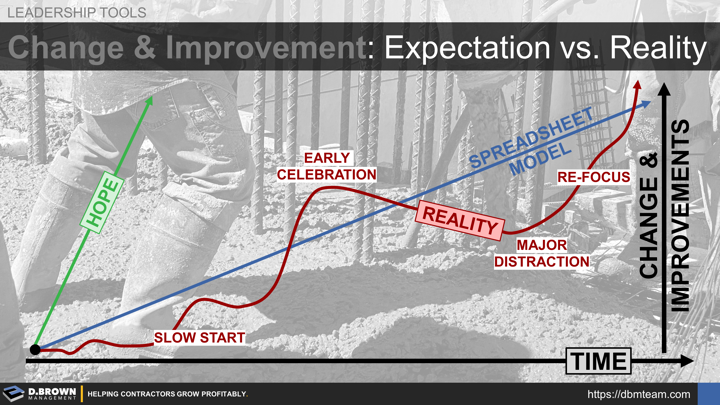It all starts with making strategic decisions at all levels of the business including setting concrete targets for milestones to know if you are on-track or not.
When you are at the brainstorming and formulation stage, your hopes are very high for what can be accomplished over what period of time.
As you build business models and schedules that take resources, constraints, and integration of other changes into account, the trajectory starts to look more realistic. If these models and schedules look good, you proceed to the next step - starting.
This is where things get messy and where we see the most failure.
We see far more failures occur due to poor execution in leading the changes and improvements than in faulty underlying strategic decisions, models, or plans. Most common failures are:
- Not putting the appropriate amount of resources into execution. This requires ruthless prioritization.
- Not engaging the whole team and ensuring they truly understand where you are headed and how.
- Not having the discipline to work toward the goal daily, weekly and monthly.
- Not utilizing feedback effectively, including feedback from failures.
Great leaders know these things will happen and they have the stamina to keep moving forward. They manage their own emotions and those of the team members. They know that their “hopes” for any major change will be far in excess of what can be realistically projected on a spreadsheet.
Most importantly they have the stamina to keep going when things get off-track as well as the emotional control to avoid early celebration when things might momentarily seem ahead of schedule.
Leading change is never easy and the rewards for doing so must come from within.
Self-Reflection Questions
- What is one major change or improvement you are working on inside your company?
- How would you evaluate the following on a 0-10 scale and why?
- The quality of the decision to make the change given the information you had at the time and all other competing priorities?
- The quality of your model, plan, and/or schedule for the change?
- Your current progress?
- If you asked the same questions about your routine business operations, how would that compare? Think about your scoreboard over time and leading measures of success.
- What is one major change or improvement you are working on personally and how does this compare? Think about broad categories of improvement including relationships, diet, fitness, parenting, hobbies, etc.
An experienced but unbiased third party can be invaluable for helping accelerate progress at all levels of decision making, planning, and execution. Be careful to avoid over-use of outside help if the root-causes include gaps in aptitude, desire, or discipline.

